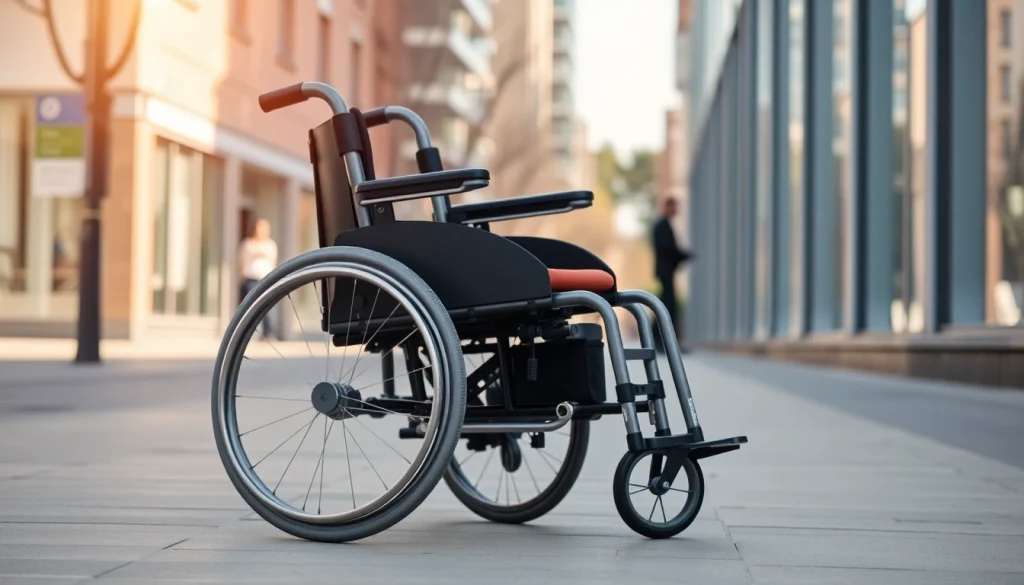Understanding NDIS Funding for Wheelchairs
The National Disability Insurance Scheme (NDIS) provides essential financial support designed to enhance the quality of life for Australians living with disabilities. Among the various aids and equipment supported by NDIS funding, wheelchairs play a crucial role in facilitating independence and mobility. Getting an NDIS fund wheelchair can significantly improve one’s lifestyle by granting improved access to daily activities and social interactions. However, understanding the nuances of NDIS funding is vital for navigating this process effectively.
What is NDIS Funding?
NDIS funding is a government initiative aimed at providing Australians living with a disability the necessary support to lead productive and fulfilling lives. This initiative not only covers basic needs but also includes funding for a wide range of assistive technologies and services, including wheelchairs. NDIS operates on the principle that individuals have the right to make choices and exercise control over their support, empowering them to select what works best for their personal circumstances.
Eligibility Criteria for NDIS Wheelchair Funding
To qualify for NDIS funding toward wheelchair acquisition, applicants must meet specific eligibility requirements. Generally, an individual must:
- Be aged between 7 and 65 years;
- Be an Australian citizen or hold a permanent visa;
- Have a permanent and significant disability that affects their ability to undertake daily activities.
In addition to these general criteria, applicants must also provide supporting evidence from professionals, such as doctors or occupational therapists, confirming their need for a wheelchair as part of their support plan.
Types of Wheelchairs Covered by NDIS
NDIS funding supports various types of wheelchairs, catered to meet different needs and preferences. Some of the primary categories include:
- Manual Wheelchairs: Ideal for users who possess upper body strength and prefer self-propulsion.
- Electric or Powered Wheelchairs: Suitable for individuals who require powered assistance due to limited upper body movement.
- Specialized Wheelchairs: These include reclining, tilt-in-space, or custom-designed options that cater to specific medical needs and comfort requirements.
When choosing a wheelchair, it is essential to consider personal needs and lifestyle factors to ensure the selected model provides optimal support.
Choosing the Right Wheelchair through NDIS
The process of selecting the right wheelchair through NDIS can be equated to finding a well-fitted shoe. It requires thoughtful deliberation of personal requirements, preferences, and professional guidance.
Assessing Personal Needs and Preferences
Before embarking on the application process for an NDIS-funded wheelchair, individuals should perform a comprehensive assessment of their needs. Factors to consider include:
- Daily activities and environment (home, work, community involvement).
- The level of mobility required and the frequency of use.
- Personal comfort, aesthetic preferences, and any additional features that may enhance usability.
Understanding the context in which a wheelchair will be used can greatly influence the decision-making process and ensure a suitable choice that meets specific lifestyle demands.
Consulting with Occupational Therapists
Engaging with a qualified occupational therapist (OT) is a crucial step in the wheelchair selection process. OTs are trained professionals who assess individual needs and can make personalized recommendations based on various factors. They can help clients navigate the complexities of wheelchair features, fit, and functionality, ensuring the selected option aligns with their physical requirements. This professional assessment typically includes:
- Physical evaluations to determine the appropriate wheelchair size and support.
- Understanding of any medical condition that may affect posture and mobility needs.
- Personal goals, such as increased independence and improved quality of life.
Through this guidance, individuals can benefit from informed choices and increased confidence in their wheelchair selection.
Evaluating Wheelchair Features and Specifications
Each wheelchair model comes with distinct features that cater to varied needs. Here are some key specifications to evaluate:
- Weight Capacity: Ensuring the wheelchair can safely support the user’s weight is paramount.
- Adjustability: Many wheelchairs offer customizable features such as height-adjustable armrests, seat depth adjustments, and tilt functionalities.
- Portability: Some users may prefer lightweight designs for easier transport, especially for those requiring frequent travel or transitioning between locations.
- Durability: Selecting a wheelchair made from high-quality materials ensures longevity and reliability.
The evaluation of features should align with the user’s lifestyle to guarantee optimal utility and satisfaction.
Applying for NDIS Funds for Wheelchairs
Once an individual is ready to proceed, the NDIS application process begins. This structured process involves multiple steps to obtain the necessary funding for wheelchair acquisition.
Step-by-Step Application Process
The application process for NDIS funding generally consists of the following steps:
- Preliminary Assessment: Ensure eligibility based on the criteria outlined previously.
- Gather Documentation: Collect relevant medical documentation and assessment reports from health professionals.
- Complete NDIS Access Request Form: This can be done online or via paper forms, requiring personal details and medical evidence.
- Receive NDIS Confirmation: After submission, applicants will receive confirmation from NDIS regarding their eligibility status.
- Planning Meeting: Attend a planning meeting for an individualized support plan that includes funding for the wheelchair.
- Purchase Wheelchair: After funding approval, individuals can proceed with purchasing the wheelchair.
Following each step diligently will enhance the likelihood of successful funding approval.
Required Documentation and Evidence
Throughout the application, applicants must submit various documents to substantiate their request. Key pieces of evidence include:
- Medical reports detailing diagnosis and the need for a wheelchair.
- Occupational therapy assessments outlining functional limitations and recommended equipment.
- Proof of residency and eligibility for NDIS support.
Providing thorough and well-organized documentation can mitigate delays and enhance the clarity of the application.
Common Challenges in the Application
While applying for NDIS funding for a wheelchair, individuals may encounter several challenges, including:
- Understanding Complex Guidelines: NDIS policies can be complicated, and understanding the requirements can be overwhelming for applicants.
- Gathering Evidence: Acquiring required documentation and securing appointments with healthcare professionals may take time.
- Waiting Periods: The review process can involve lengthy waiting times, which can be frustrating.
To address these challenges, applicants can benefit from support from advocacy groups or seek guidance from professionals experienced in navigating NDIS applications.
Maximizing Your NDIS Wheelchair Experience
After successfully obtaining funding for a wheelchair, it is essential to maximize the experience and ensure the wheelchair remains functional and adapted to users’ ongoing needs.
Tips for Maintaining Your Wheelchair
To prolong the usability and functionality of the wheelchair, users should consider the following maintenance tips:
- Regularly inspect the wheelchair for any signs of wear and tear and address issues promptly.
- Keep all moving parts clean and lubricated to facilitate smooth operation.
- Ensure that wheel tires are inflated to the appropriate pressure to maintain performance.
- Schedule periodic check-ups with suppliers or healthcare professionals for major servicing.
Routine maintenance not only extends the life of the wheelchair but also contributes to user safety and comfort.
Resources for Support and Community
Participating in community resources and support networks can provide invaluable assistance and camaraderie for wheelchair users. Useful resources include:
- Local disability advocacy groups that offer advice and support in navigating NDIS.
- Online forums and communities where users can share experiences and recommendations.
- Workshops and events that cover topics related to mobility aids and independent living.
Engaging with these resources can foster a sense of belonging and provide users with tools to enhance their daily experiences.
Adaptations for Enhanced Usage
To further enhance the usability of a wheelchair, individuals can explore various adaptations, such as:
- Seating Modifications: Custom cushions and backrests tailored to individual comfort levels.
- Assistive Technologies: Incorporating smart technology, such as joystick controls and automated functions, can significantly improve ease of use.
- Custom Accessories: Add-ons such as cup holders, storage baskets, and safety straps can enhance convenience and accessibility.
Implementing these adaptations can transform the wheelchair from a basic mobility tool into a truly personalized mobility solution.
Future of NDIS Fund Wheelchair Technology
The landscape of wheelchair technology is ever-evolving, with innovations continually reshaping user experiences and mobility solutions.
Innovations in Wheelchair Design
Recent advancements in wheelchair technology have brought forth creative designs that offer improved functionality and comfort. Innovations such as:
- Smart Wheelchairs: Equipped with sensors and AI, these wheelchairs can navigate environments independently and provide real-time data to inform care decisions.
- Foldable and Lightweight Designs: These models cater to active individuals who require mobility aids that are easy to transport.
- Advanced Seating Systems: Incorporating dynamic seating, users can achieve better pressure relief and overall comfort improvements.
Such innovations not only provide users with enhanced mobility but also promote dignity and independence.
Developments in Funding Policies
As wheelchair technology continues to advance, so do funding policies associated with NDIS. Policymakers are shifting towards more inclusive funding frameworks, ensuring that innovative technology becomes accessible. Key developments include:
- Expanded definitions of assistive technologies to cover a broader range of mobility solutions.
- Increased funding caps for technologically advanced wheelchairs to keep pace with innovations.
- Streamlined application processes tailored for rapidly evolving technologies.
Such policy adaptations aim to ensure that individuals with disabilities remain at the forefront of receiving the latest and most effective mobility solutions.
Advocacy for Better Mobility Solutions
Advocacy groups play a pivotal role in representing the needs and concerns of wheelchair users. Engagement in advocacy efforts leads to:
- Increased awareness among lawmakers about the challenges faced by wheelchair users.
- Promoting community support initiatives that prioritize accessibility and independence.
- Encouraging collaboration between technology developers and organizations to create user-focused designs.
Continuous advocacy is essential for driving meaningful changes in policies and technology that support enhanced mobility solutions.


